
Ever mistaken silver for platinum or vice versa?
You are not alone! At first look, these two metals appear to be siblings due to their silver shine. However, upon closer inspection, their differences become clear. When you compare platinum vs silver, several distinct characteristics emerge, each with its own allure.
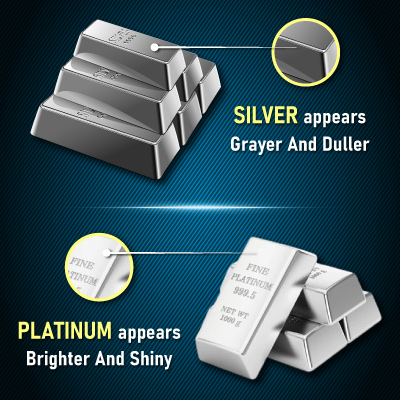
Silver appears a little grayer and duller, while platinum has a brighter, shiny appearance with grey undertones.
Furthermore, the price of silver is about 1.67% that of platinum. Though they may look alike, each metal has specific features that make them useful for different kinds of applications. Whether you're looking for a promise to uphold their value over time.
Let’s dig deeper into platinum vs silver.
Popular culture often glorifies gold as the ultimate precious metal, and it has led many to assume it's rarer than any other metal found on Earth.
The World Platinum Investment Council has revealed that platinum is surprisingly thirty times rarer than gold! While over 3,300 metric tonnes of gold are mined each year, only roughly 190 metric tonnes of platinum are extracted globally.
Because of its unique properties, platinum is widely used in many different industries.
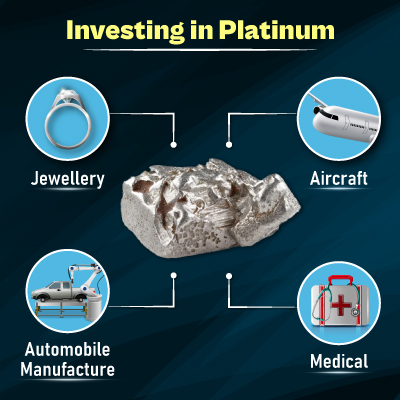
It is extremely valuable in industries including jewelry, aircraft, automobile manufacture, and medical due to its high density and malleability.
The dynamics of industrial supply and demand have a significant impact on the value of platinum, leading to frequent fluctuations in the price.
Investors can purchase real platinum, such as coins, bars, or they can choose to purchase equities, mutual funds, or exchange-traded funds (ETFs).
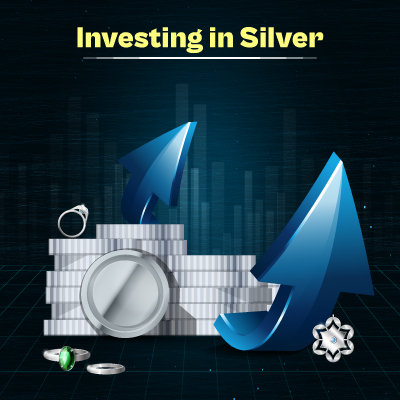
Silver, a valued precious metal with a centuries-long history, is highly malleable and ductile, resulting in easy processing.
This property, along with its susceptibility to tarnishing and corrosion, impacts its suitability for many different purposes, particularly in jewelry.
In terms of look, silver has a brilliant white color.
To boost its strength and resilience, silver is often mixed with other metals. A millesimal fineness number, which represents the amount of pure silver in a particular piece, is commonly used to define the purity of silver.
When it comes to investment, silver retains its value over time, and investors have two options: they can buy actual silver, such as coins, or they can buy stocks, mutual funds, or exchange-traded funds (ETFs).
So whether you choose to invest in silver or platinum , both offer exceptional liquidity and value. Choosing between bars, coins, or stocks depends on your individual objectives.
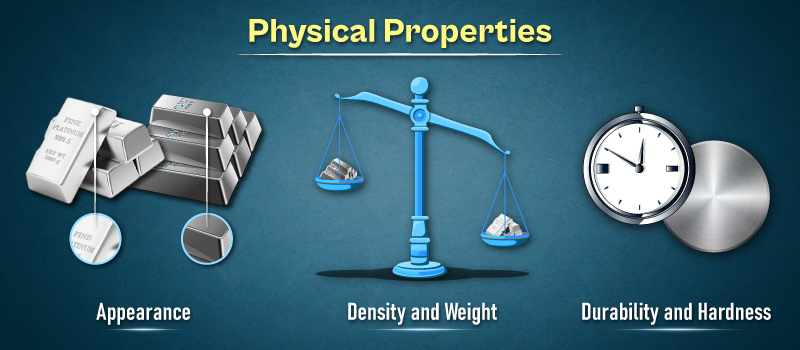
While gold's yellow undertone makes it easy to identify, platinum and silver appear identical to the untrained eye due to comparable gray undertones. However, platinum is readily distinguished from silver by its white color and outstanding luster compared to silver's dull, gray appearance.
The shine of platinum surpasses that of even the finest silver alloys. Furthermore, compared to softer metals, platinum is more resilient and likely to maintain its aesthetic appeal.
Silver is a delicate metal that tarnishes easily and wears down quickly. Platinum is a more dense metal with a high melting point.
While silver is lighter and less dense, it will weigh about 10 grams/cc, and platinum will weigh about 18 grams/cc.
When it comes to durability, platinum easily outperforms silver. It is extremely durable and has a high melting point. Since its durability, platinum is the material of choice for exquisite jewelry with gemstone settings since the jewels are kept firmly in place.
Gems may eventually fall out of silver as they age and begin to lose their shape. Silver is a delicate metal that is prone to scratching and tarnishing. Silver and other metals are often mixed to make jewelry stronger.
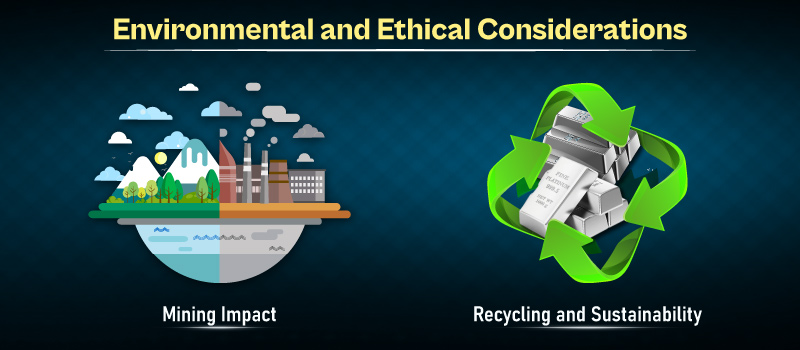
The majority of silver mining releases a lot of mercury into the soil, water, and air. On the other hand, platinum mining can result in numerous ecological concerns such as erosion, sinkholes, biodiversity loss, and chemical contamination of surface water, groundwater, and soil.
Through carbon emissions, these processes also have an impact on the atmosphere which leads to climate change.
Platinum and silver are both very recyclable metals. When products with platinum or other platinum group metals (PGMs) are no longer used, the PGMs can be extracted through smelting and refining.
This creates a sustainable source of these limited resources. Likewise, over 70% of the silver in use today comes from recycled sources, showing its high recyclability as well.
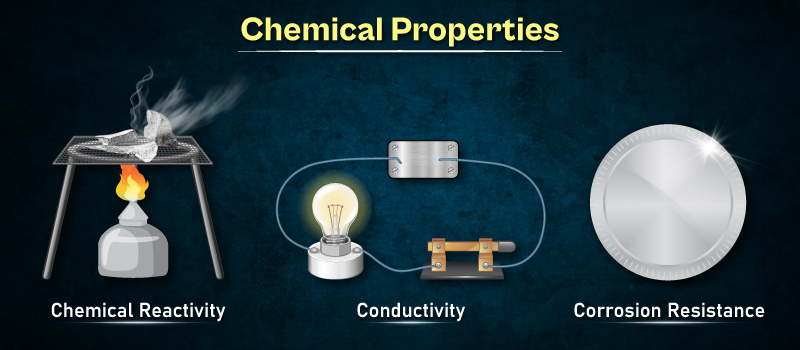
Silver doesn't react with air, even at high temperatures, which is why alchemists called it a noble metal! It's less reactive than copper, which forms copper(I) oxide when heated, but more reactive than gold. Platinum is even less reactive than silver.
It doesn't oxidize in air at any temperature and is resistant to acids, except aqua regia. However, it reacts with fused alkali oxides, peroxides, fluorine, and chlorine at high temperatures.
Silver doesn't oxidise easily, which makes it resistant to corrosion. Its surface develops a layer of silver sulphide when exposed to air.
On the other hand, platinum has exceptional resistance to corrosion. In the air, it does not oxidize at any temperature; however, it does form a thin PtO2 surface layer that can be removed by heating it to about 400°C.
Platinum conducts electricity impressevely well, with a thermal conductivity of about 70 W/m/K at ambient conditions, increasing by about three times with temperature and pressure changes!
Yet, of all the metals, silver takes the crown of the highest electrical conductivity, which makes it extremely useful in electronics. It is often used for soldering, electrical connections, and printed circuit boards.
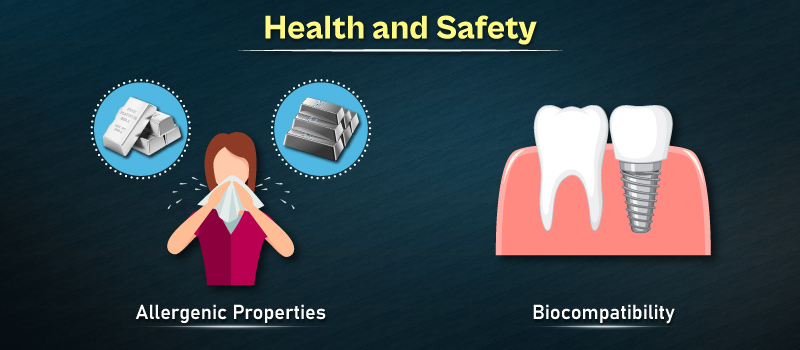
Platinum is widely regarded as the only entirely hypoallergenic metal, while pure silver is generally hypoallergenic but not always.
Sterling silver, comprising 92.5% silver and 7.5% copper, is hypoallergenic and safe for most wearers.
Platinum's biocompatibility makes it ideal for a variety of medical implants due to its ability to be molded into intricate structures.
On the other hand, although silver is not natively biocompatible, silver nanoparticles are used in implant antibacterial coatings. However, mammalian cells may be toxically affected by the usage of silver nanoparticles alone.
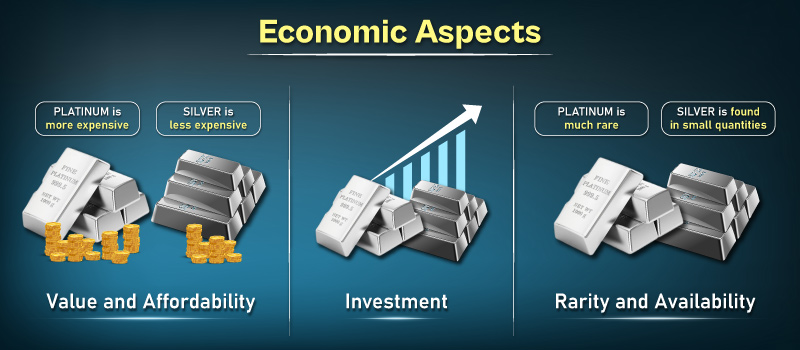
Due to their scarcity and many uses in specialized industries like the automotive and electronics sectors, precious metals like platinum and silver have great value. Inflation and economic downturns have minimal impact on them.
When it comes to purchasing jewelry, coins, or bars, silver is a more affordable metal due to its high availability. The world's supply of platinum is produced by just a few nations, making it one of the rarest metals on Earth.
It is one of the most expensive metals due to its extensive use in automobile manufacturing and its limited supply.
Silver ranks as the 68th most abundant element in the Earth's crust and 65th in cosmic abundance. It's found in small quantities across various locations on Earth, with significant mining operations in North and South America accounting for over half of the world's production.
In contrast, platinum is much rarer, with an average abundance of about 5 µg/kg in the Earth's crust. As of 2023, global reserves of platinum group metals (PGMs) were estimated at around 71,000 metric tons, with approximately 88 percent located in South Africa's crust.
Due to its affordability when compared to other precious metals, silver is a popular investment in precious metals. Although it is less expensive than gold and platinum, its price is equally volatile.
While both silver and platinum are in demand throughout a number of industries, the price of platinum is highly affected by these sectors. The automobile industry is in significant demand for platinum because it is one of the key metals used in catalytic converters.
By purchasing actual bars and coins, people often make investments in platinum and silver. The majority of platinum coins and silver coins are over 99% pure, making them suitable for IRA investments or coin collecting.
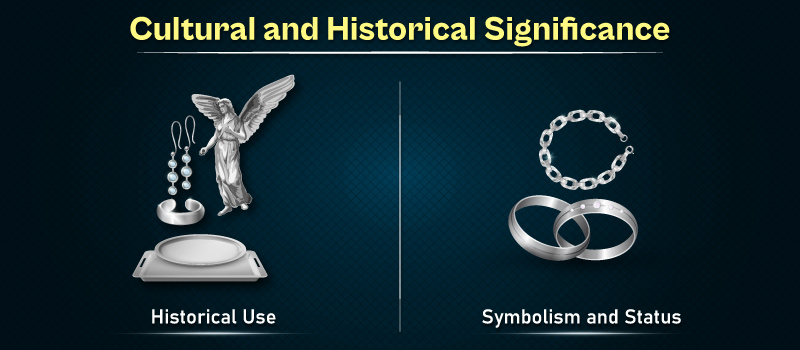
Back in ancient times, people used silver to make jewelry, plates, and statues. They also used hack silver, which was like chunks of silver used for trading or saving money. Archaeologists, on the other hand, found bits of platinum mixed in with gold in old Egyptian tombs from about 1200 BCE. Also, Native Americans in a place called Esmeraldas, which is in Ecuador today, made things from a mix of gold and platinum.
Platinum is often used for wedding bands and engagement rings because it represents power, strength, and eternal love.
Silver is regarded as an auspicious metal with spiritual significance. It is thought to have cleansing effects and is related to the moon, which symbolizes feminine energy, intuition, and balanced emotions.
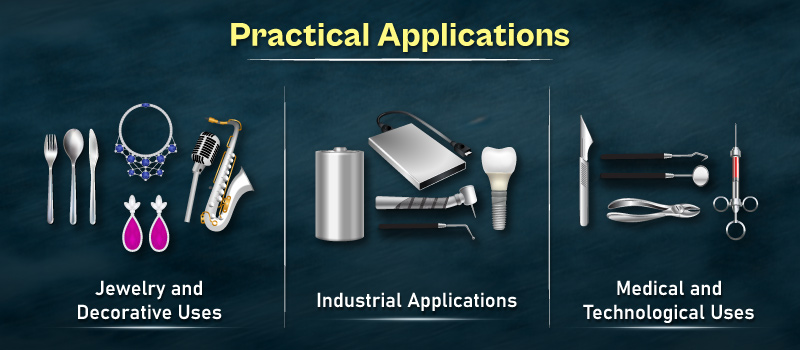
Platinum's rarity, purity, and natural white color have made it a favored decorative material since the 7th century BC.
Today, it's highly popular for bridal and fashion jewelry, especially in Asia. Silver, discovered after gold and copper around 4000 BCE, boasts malleability and corrosion resistance, making it ideal for crafting ornamental items, tableware, musical instruments, and decorative hardware.
Silver has a wide range of industrial applications, including electrical cables and electronics, batteries, dentistry, photography, and water filtration.
Platinum, on the other hand, is used in plastics, detergents, fertilisers, computers, hard drives, and thermocouples, among other industrial processes as a catalyst.
Platinum is used in producing key components for various medical devices such as pacemakers, implantable defibrillators, catheters, stents, and neuromodulation devices.
On the other hand, silver has medical applications in wound dressings and creams, as well as as an antibiotic coating on medical devices. Additionally, silver is utilized in wound care, bone prostheses, reconstructive orthopedic surgery, cardiac devices, catheters, and surgical appliances.
| Criterion | Platinum | Silver |
|---|---|---|
| Budget | It is one of the most expensive metals after gold. | One of the most affordable metals, and the price of silver is about 1.67% that of platinum. |
| Durability | Platinum is more durable than silver due to its higher density and resistance to tarnishing and corrosion. | Silver is less durable compared to platinum as it tarnishes easily and wears down quicker. |
| Maintenance | Platinum requires minimal maintenance and retains its appearance well over time. | Silver requires more maintenance as it tarnishes easily and needs regular cleaning to maintain its shine. |
| Appearance | Platinum has a bright, shiny appearance with gray undertones. | Silver has a brilliant white color, but it can appear grayer and duller compared to platinum. |
| Skin Sensitivity | Platinum is widely regarded as hypoallergenic and safe for most wearers. | Pure silver is generally hypoallergenic, but not all types are completely hypoallergenic. |
| Investment | Platinum is rarer and more valuable than silver, making it a potentially lucrative investment. | Silver retains its value over time and can be a good investment option due to its widespread industrial use and affordability. |
| Environmental Impact | Platinum mining can result in ecological concerns such as erosion, biodiversity loss, and chemical contamination. | Silver mining releases mercury into the environment, impacting soil, water, and air quality. |
| Ideal For | Platinum is ideal for fine jewelry, especially bridal and fashion jewelry, as well as industrial applications due to its durability and rarity. | Silver is suitable for various jewelry, decorative, and industrial applications, offering affordability and malleability. |
Silver vs platinum? It's pretty simple!
When it comes to durability and maintenance, platinum outperforms silver in the world of jewelry. Perhaps you want to buy one of these metals as an investment. If so, your budget and plan should come into play.
Silver costs far less than platinum, which occasionally costs more than gold. So, whatever you choose simply depends on your investment goals and budget.
Whether you want to buy silver coins or platinum coins like a platinum maple leaf coin, visit BOLD Precious Metal's official website to see an authentic collection of precious metal bullion.